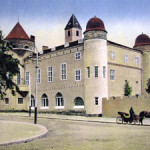The first museums in Finland were established in the last half of the 19th century, at the same time as growing sense of nationalism emerged within Finland (Finland was then part of Tsarist Russia). With this growing sense of a Finnish identity came a concurrent pride in Finnish language and cultural identity – and so the first historical societies began to be formed and the first history museums in Finland established.
Today there are 22 regional historical museums in Finland. These regional museums also provide extensive support and guidance for the numerous other museums in their respective regions, and play a considerable role in their promotion. This in itself is no small task as there are over one thousand museums in Finland. Need I say that many of Finland’s museums are quite fascinating and well worth visiting. And the variety of the subjects covered by the various museums is quite staggering.
The central control for all regional museums of cultural history is the National Museum of Finland. The following list introduces only some of the larger historical museums in Finland. Subsequent Posts will cover both these and other museums in more detail – both by subject matter and by region. This post is more by way of a general introduction and to arouse your interest.
The National Museum of Finland – Helsinki
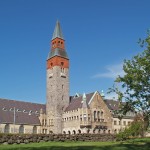
National Museum of Finland
Located in a rather charming building designed in the National Romantic style (the architects were Gesellius, Lindgren, and Eliel Saarinen who won an architectural competition for the project in 1902) in central Helsinki, the National Museum was built between 1905 and 1910 and opened to the public in 1916. Within the museum, the vaulted central hall leads to the various departments. Featured on the vaults are frescoes painted by Akseli Gallen-Kallela from 1928 based on themes from the Finnish National Epic, the Kalevala: Sammon taonta (The Forging of the Sampo), Sammon puolustus (The Defence of the Sampo), Ilmarinen kyntää kyisen pellon (Ilmarinen Ploughs a Field of Vipers) and Iso hauki (The Great Pike). They are based on the frescoes painted by Gallen-Kallela for the Finnish pavilion of the Paris World Exposition of 1900.
The National Museum of Finland presents Finnish history from the Stone Age to the present. Permanent exhibitions are divided into 6 separate sections: The Treasure Troves – collections of coins, medals, orders and decorations, silver, jewelry and weapons; Prehistory of Finland – this is the largest permanent archaeological exhibition in Finland; The Realm – exploring the development of Finnish society and culture from the Middle Ages (12th century) to the early 20th century; The Land and Its People – Finnish folk culture in the 18th-19th centuries; and The 20th century exhibition which presents independent Finland, its history and culture. If you’re in Helsinki (and most visitors to Finland are), this is one of the places you really should spare some time for.
The Northern Ostrobothnian Museum – Oulu
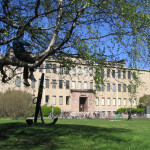
Northern Ostrobothnian Museum
The Northern Ostrobothnian Museum displays the cultural history of Oulu and the surrounding province of Ostrobothnia. A permanent exhibition explores the regions history from the prehistoric to the modern era. There is a permanent exhibition for children based on the Doghill books by Finnish children’s author Mauri Kunnas. The ground floor also hosts a large scale model of Oulu city centre in the year 1938 and there is also a Lapland section which displays a tribute to the life and work of Samuli Paulaharju, an influential and prolific Sámi author and folklorist.
The museum was founded in 1896 and was maintained by a museum society until 1969, when ownership was handed over to the city of Oulu. Between 1911 and 1929 the museum was in an old wooden villa, the Villa Ainola, which was destroyed by fire on July 9, 1929. Soon after the fire the current museum building was built on the site of the old villa and was was completed in 1931. The museum was designed by a Finnish architect Oiva Kallio and can be found in Ainola Park in the Myllytulli neighbourhood of Oulu.
Siida – Sámi Museum and Northern Lapland Nature Centre – Inari
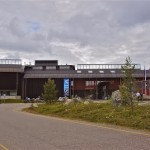
Sami Museum
On the shores of Lake Inari in the village of Inari, Siida is home to the Northern Lapland Nature Centre and to the Sámi Museum. Siida documents and display the cultural and spiritual heritage of the Finnish Sámi in its collections and also has an open-air museum in the summers. The first log buildings were moved to the museum grounds in 1960 from the Sámi community of Tirro and represent the way the Sámi who owned a homestead lived in the 1800s. The museum also displays movable Sámi lodges, tents and sod huts, as well as storage buildings and hunting traps. There is also a gold prospector’s cabin on the creek that runs through the museum grounds and a shelter contains the boats, sleds and other equipment needed by the Sámi for transportation.The 7-hectare (17-acre) site now has nearly 50 points of interest related to Lapland’s nature and the Sámi and their culture.
The area is also one where the earliest inhabitants of Northern Lapland lived and archaeological digs have identified remains from around 9,000 years ago. The archaeological excavations conducted in the area have identified remains and artifacts that tell us of the life of the paleolithic hunting and fishing population that lived here. The findings include dwelling sites and hearths, as well as different types of tools, pottery and burned bone.
Military Museum of Finland – Helsinki
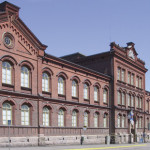
Sotamuseo Helsinki (Military Museum)
Considering Finland’s location between Sweden and Russia, and the number of wars fought between those two nations, it is hardly surprising that one of the country’s largest museums is devoted to the nation’s military history. In the exhibition visitors can familiarise themselves with the military history of Finland, from the periods when Sweden and Imperial Russia ruled Finland, through the struggle for independence and the wars of 1939-1945, down until the current period. Weaponry, equipment, uniforms, medals, flags and art with military themes from the various periods are on display. Photographic and archive material and multimedia complement the artefacts. There is a heavy emphasis on the Winter War exhibition, which deals with the Soviet attack on Finland that started on 30th November 1939 and ended on 13th March 1940. This museum is one of the little-known gems of Helsinki and an absolute must for any buff of military history, with all displays being of a very high standard. For non-Finnish speakers, everything is in English including the option to watch various films in the language of your choice. It is very well set out and if you are taking children along, they will certainly enjoy it.
The Museum of Central Finland – Jyväskylä
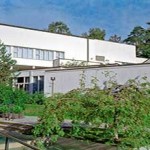
Museum of Central Finland
Located centrally in the city of Jyväskylä, the Museum of Central Finland serves both as a local museum for Jyväskylä and as the provincial museum for the region, and tells the history of the region from pre-history to the modern era. There are also temporary exhibitions which deal with aspects of cultural history, and art exhibitions also play a part in the museums programme. There are two craftsmen’s houses restored and on display on the premises. Additionally, the Pienmäki Farm Buildings Museum in Hankasalmi, a School Museum at Jyväskylä Lyceum, Jyväskylä Museum of Municipal Engineering and the home of the Heiska artist family are all cared for by the museum.
Jyväskylä has a rich collection of museums, including also: the Alvar Aalto Museum, which displays the artist’s most important work and design, the Craft Museum of Finland, the Aviation Museum of Central Finland near the Jyväskylä Airport in Tikkakoski, the University of Jyväskylä Museum, the Jyväskylä Art Museum is located in the city centre. Another art museum centre – The Halonen building – is near the main railway station and consists of The Centre for Creative Photography, the Centre for Printmaking and Galleria Harmonia.
Provincial Museum of Lapland – Rovaniemi
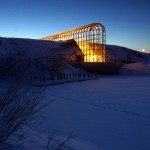
Artikum Museum
The eye-catching Alvar Aalto-designed Artikum building in Rovaniemi holds the Provincial Museum of Lapland and displays the cultural heritage and the unique natural habitats of Lapland. Aside from themed exhibitions that are updated regularly, there is a permanent exhibition named “Northern Ways” that features the development of life in the Arctic from prehistory to the present day through displays of its archaeological, ethnological and natural historical collections and an extensive photographic archive.The exhibition on prehistory is illustrated by dioramas and miniature models. As the central museum of the region, the Provincial Museum of Lapland also displays Sami culture. At the exhibition, you can learn more about the Sami languages and traditional music; costumes, handicrafts and reindeer husbandry.
You can also find out about the life of the moose and bear in the wild as well as the mythology surrounding these great northern animals. The exhibition also features models of Rovaniemi from 1939 and 1944 (Rovaniemi was completely destroyed by the retreating German Army in 1944). You will also find the University of Lapland’s Arctic Centre in the same building – the Arctic Centre’s main exhibition has displays on ice caves, the arctic rivers, research stations and the arctic seasons and also includes the northern lights theatre.
Regional Museum of South Karelia – Lappeenranta
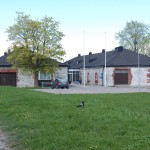
South Karelia Museum
Situated in the historic Fortress of Lappeenranta, where most of the other buildings are also museums, the Regional Museum of South Karelia is housed in the grey-stone buildings which were once the artillery depot. The collections displayed here have been gathered from the museums of Lappeenranta, Vyborg and Käkisalmi (Priozersk) and the permanent exhibition is devoted to the local history and prehistory of the surrounding areas and to the history of this area. Apart from the permanent exhibition, the museum also stages various temporary exhibitions which are often linked to topical themes. These exhibitions are either put together by the museum itself, or are touring exhibitions on loan.
One of the main attractions of the permanent exhibition is a scale model of Vyborg, showing the town as it was on the 2nd of September 1939, shortly before the Soviet attack on Finland. The surface area of the model is 24 square metres, and it covers the area from Patterinmäki to Siikaniemi and from Havi to Papula. The model includes models of people, cars, trams, trains and ships, all going about their day to day business. The museum’s work of preservation and recording, research and display encompasses not only the present-day region of South Karelia but also the southern part of Karelia which was ceded to Russia at the end of the Continuation War (WW2), i.e. the Karelian Isthmus.
Kupio Museums of Cultural & Natural History – Kuopio
Located in an impressive Art Nouveau building that’s over 100 years old, the Kuopio Museum of Cultural History was founded on 20 February 1897, making it the second oldest natural history museum in Finland. After operating for years in temporary accommodation, the Museum was transferred in the year 1907 to the present Kuopio Museum building, which together with the cultural history collection and the city library, was planned by architect J.V. Strömberg. The museum serves as the provincial museum of Northern Savo, whose task it is to research, preserve and display the cultural history of the region. The permanent collection includes peasant artifacts, traditional peasant house interiors, and offers an insight into life from prehistoric times to the present day. The neighboring Museum of Natural History (the two museums are co-located in the same building) has the distinction of being the only Finnish museum to include reconstructions of a mammoth as well as of Finland’s first inhabitants – the Neanderthal people. As with many other Finnish cities, Kuopio has a number of other museums, all worth a visit if you’re in the area.
History Museums in Finland
There’s a wide range of other history museums in Finland that I’ll be covering in other posts. This summary of the larger museums is really just touching the surface of what’s there.
 Copyright secured by Digiprove © 2013 Alternative Finland
Copyright secured by Digiprove © 2013 Alternative Finland


